Research on Deformation Evolution of a Large Toppling Based on Comprehensive Remote Sensing Interpretation and Real-Time Monitoring
Abstract
:1. Introduction
2. Materials and Methods
2.1. Study Area
2.2. Methods
2.2.1. On-Site Monitoring
2.2.2. SBAS-InSAR
2.2.3. Multi-Period Image
3. Results
3.1. Real-Time Monitoring Results
3.1.1. Fixed Non-Prism Monitoring
3.1.2. GNSS Monitoring
3.1.3. Deep Displacement Monitoring
3.2. SBAS-InSAR Data
3.2.1. Slope Surface Deformation Monitoring Based on SBAS-InSAR
3.2.2. Precision of SBAS-InSAR
3.3. Multi-Phase Image Data
4. Discussion
4.1. Spatio-Temporal Deformation Evolutionary Characteristics
4.2. Deformation Sensitivity
4.3. Geological Model
5. Conclusions
Author Contributions
Funding
Data Availability Statement
Conflicts of Interest
References
- Cui, S.H.; Pei, X.J.; Jiang, Y.; Wang, G.H.; Fan, X.M.; Yang, Q.W.; Huang, R.Q. Liquefaction within a bedding fault: Understanding the initiation and movement of the Daguangbao landslide triggered by the 2008 Wenchuan Earthquake (Ms = 8.0). Eng. Geol. 2021, 295, 106455. [Google Scholar] [CrossRef]
- Huang, R. Mechanisms of large-scale landslides in China. Bull. Eng. Geol. Environ. 2012, 71, 161–170. [Google Scholar] [CrossRef]
- Cenni, N.; Fiaschi, S.; Fabris, M. Integrated use of archival aerial photogrammetry, GNSS, and InSAR data for the monitoring of the Patigno landslide (Northern Apennines, Italy). Landslides 2021, 18, 2247–2263. [Google Scholar] [CrossRef]
- Eberhardt, E.; Watson, A.D.; Loew, S. Improving the interpretation ofslopemonitoring and early warning data through better understanding of complex deep-seated landslide failure mechanisms. In Landslides and Engineered Slopes: From the Past to the Future; Chen, Z., Zhang, J., Li, Z., Wu, F., Ho, K., Eds.; Taylor & Francis: London, UK, 2008; pp. 39–51. [Google Scholar]
- Irfan, M.; Uchimura, T.; Chen, Y. Effects of soil deformation and saturation on elastic wave velocities in relation to prediction of rain-induced landslides. Eng. Geol. 2017, 230, 84–94. [Google Scholar] [CrossRef]
- Shou, K.J.; Wang, C.F. Analysis of the Chiufengershan landslide triggered by the 1999 Chi-Chi earthquake in Taiwan. Eng. Geol. 2003, 68, 237–250. [Google Scholar] [CrossRef]
- Tang, H.; Liu, X.; Hu, X.; Griffiths, D.V. Evaluation of landslide mechanisms characterized by high-speed mass ejection and long-run-out based on events following theWenchuan earthquake. Eng. Geol. 2015, 194, 12–24. [Google Scholar] [CrossRef]
- Huang, R.Q. Some catastrophic landslides since the twentieth century in the southwest of China. Landslides 2009, 6, 69–81. [Google Scholar]
- Sun, H.; Wu, X.; Wang, D.; Xu, H.; Liang, X.; Shang, Y. Analysis of deformation mechanism of landslide in complex geological conditions. Bull. Eng. Geol. Environ. 2019, 78, 4311–4323. [Google Scholar] [CrossRef]
- Song, H.F.; Cui, W. A large-scale colluvial landslide caused by multiple factors: Mechanism analysis and phased stabilization. Landslides 2016, 13, 321–335. [Google Scholar] [CrossRef]
- Zangerl, C.; Eberhardt, E.; Perzlmaier, S. Kinematic behaviour and velocity characteristics of a complex deep-seated crystalline rockslide system in relation to its interaction with a dam reservoir. Eng. Geol. 2010, 112, 53–67. [Google Scholar] [CrossRef]
- Vallet, A.; Charlier, J.B.; Fabbri, O.; Bertrand, C.; Carry, N.; Mudry, J. Functioning and precipitation-displacement modelling of rainfall-induced deep-seated landslides subject to creep deformation. Landslides 2015, 13, 653–670. [Google Scholar] [CrossRef]
- Xie, M.L.; Zhao, W.H.; Ju, N.P.; He, C.; Huang, H.; Cui, Q. Landslide evolution assessment based on InSAR and real-time monitoring of a large reactivated landslide, Wenchuan, China. Eng. Geol. 2020, 277, 105781. [Google Scholar] [CrossRef]
- Cina, A.; Piras, M. Performance of low-cost GNSS receiver for landslides monitoring: Test and results, Geomatics. Nat. Hazards Risk 2015, 6, 497–514. [Google Scholar] [CrossRef]
- Li, M.; Zhang, L.; Dong, J.; Tang, M.; Shi, X.; Liao, M.; Xu, Q. Characterization of pre- and post-failure displacements of the Huangnibazi landslide in Li County with multi-source satellite observations. Eng. Geol. 2019, 257, 105140. [Google Scholar] [CrossRef]
- Farina, P.; Colombo, D.; Fumagalli, A.; Marks, F.; Moretti, S. Permanent scatterers for landslide investigations: Outcomes from the ERS-SLAM project. Eng. Geol. 2006, 88, 200–217. [Google Scholar] [CrossRef]
- Bulmer, M.H.; Petley, D.N.; Murphy, W.; Mantovani, F. Detecting slope deformation using two-pass differential interferometry: Implications for landslide studies on Earth and other planetary bodies. J. Geophys. Res. 2006, 111, E06S16. [Google Scholar] [CrossRef]
- Cascini, L.; Fornaro, G.; Peduto, D. Advanced low- and full-resolution DInSAR map generation for slow-moving landslide analysis at different scales. Eng. Geol. 2010, 112, 29–42. [Google Scholar] [CrossRef]
- Zhao, C.Y.; Lu, Z.; Zhang, Q.; Fuente, J.D.L. Large-area landslides detection and monitoring with ALOS/PALSAR imagery data over Northern California and Southern Oregon, USA. Remote Sens. Environ. 2012, 124, 348–359. [Google Scholar] [CrossRef]
- Hilley, G.E.; Burgmann, R.; Ferretti, A.; Novali, F.; Rocca, F. Dynamics of slow-moving landslides from permanent scatterer analysis. Science 2004, 304, 1952–1955. [Google Scholar] [CrossRef] [PubMed]
- Roering, J.J.; Stimely, L.L.; Mackey, B.H.; Schmidt, D.A. Using DInSAR, airborne LiDAR, and archival air photos to quantify landsliding and sediment transport. Geophys. Res. Lett. 2009, 36, L19402. [Google Scholar] [CrossRef]
- Stimely, L.L. Characterizing Landslide Movement at the Boulder Creek Earthflow, Northern California, Using L-Band InSAR. Master’s Thesis, Department of Geological Sciences, Graduate School of the University of Oregon, Eugene, OR, USA, 2009. [Google Scholar]
- Calabro, M.D.; Schmidt, D.A.; Roering, J.J. An examination of seasonal deformation at the Portuguese Bend landslide, southern California, using radar interferometry. J. Geophys. Res. 2010, 115, F02020. [Google Scholar] [CrossRef]
- Xia, Y.; Kaufmann, H.; Guo, X.F. Landslide monitoring in the Three Gorges area using D-INSAR and corner reflectors. Photogramm. Eng. Remote Sens. 2004, 70, 1167–1172. [Google Scholar]
- Fu, X.; Guo, H.; Tian, Q.; Guo, X. Landslide monitoring by corner reflectors differentialinterferometry SAR. Int. J. Remote Sens. 2010, 31, 6387–6400. [Google Scholar] [CrossRef]
- Calò, F.; Ardizzone, F.; Castaldo, R.; Lollino, P.; Tizzani, P.; Guzzetti, F.; Lanari, R.; Angeli, M.G.; Pontoni, F.; Manunta, M. Enhanced landslide investigations through advanced DInSAR techniques: The Ivancich case study, Assisi, Italy. Remote Sens. Environ. 2014, 142, 69–82. [Google Scholar] [CrossRef]
- Motagh, M.; Akbarimehr, M.; Haghshenas-Haghighi, M. Slope Stability Assessment of the Sarcheshmeh Landslide, Northeast Iran, Investigated Using InSAR and GPS Observations. Remote Sens. 2013, 5, 3681–3700. [Google Scholar]
- Carlà, T.; Tofani, V.; Lombardi, L.; Raspini, F.; Bianchini, S.; Bertolo, D.; Thuegaz, P.; Casagli, N. Combination of GNSS, satellite InSAR, and GBInSAR remote sensing monitoring to improve the understanding of a large landslide in high alpine environment. Geomorphology 2019, 335, 62–75. [Google Scholar] [CrossRef]
- Allasia, P.; Manconi, A.; Giordan, D.; Baldo, M.; Lollino, G. ADVICE: A new approach for near-real-time monitoring of surface displacements in landslide hazard scenarios. Sensors 2013, 13, 8285–8302. [Google Scholar] [CrossRef]
- Bai, S.B.; Lu, P.; Thiebes, B. Comparing characteristics of rainfall and earthquake triggered landslides in the upper Minjiang catchment, China. Eng. Geol. 2020, 268, 105518. [Google Scholar] [CrossRef]
- Zhou, R.J.; Alexander, L.D.; Michael, A.E.; He, Y.L.; Li, Y.Z.; Li, X.G. Active tectonics of the Longmen Shan region on the eastern Margin of the Tibetan Plateau. Acta. Geol. Sin. Engl. Ed. 2007, 81, 593–604. [Google Scholar]
- Kirby, E.; Whipple, K.X.; Burchfiel, B.C.; Tang, W.T.; Berger, G.; Sun, Z.M.; Chen, Z.L. Neotectonics of the Min Shan, China: Implications for mechanisms driving Quaternary deformation along the eastern margin of the Tibetan Plateau. Geol. Soc. Am. Bull. 2000, 112, 375–393. [Google Scholar] [CrossRef]
- Kirby, E.; Reiners, P.W.; Krol, M.A.; Whipple, K.X.; Hodges, K.V.; Farley, K.A.; Tang, W.; Chen, Z. Late Cenozoic evolution of the eastern margin of the Tibetan Plateau: Inferences from 40Ar/39Ar and (U-Th)/He thermochronology. Tectonics 2002, 21, 1–20. [Google Scholar] [CrossRef]
- Li, C.; Xu, W.; Wu, J.; Gao, M. Using new models to assess probabilistic seismic hazard of the North–South Seismic Zone in China. Nat. Hazards 2016, 82, 659–681. [Google Scholar] [CrossRef]
- Shao, C.; Li, Y.; Lan, H.; Li, P.; Zhou, R.; Ding, H.; Yan, Z.; Dong, S.; Yan, L.; Deng, T. The role of active faults and sliding mechanism analysis of the 2017 Maoxian postseismic landslide in Sichuan, China. Bull. Eng. Geol. Environ. 2019, 78, 5635–5651. [Google Scholar] [CrossRef]
- Berardino, P.; Fornaro, G.; Lanari, R.; Sansosti, E. A new algorithm for surface deformation monitoring based on small baseline differential SAR interferograms. IEEE Trans. Geosci. Remote Sens. 2002, 40, 2375–2383. [Google Scholar] [CrossRef]
- Zhao, R.; Li, Z.; Feng, G.; Wang, Q.; Hu, J. Monitoring surface deformation over permafrost with an improved SBAS-InSAR algorithm: With emphasis on climatic factors modeling. Remote Sens. Environ. 2016, 184, 276–287. [Google Scholar] [CrossRef]
- Wu, L.Z.; Zhao, D.J.; Zhu, J.D.; Peng, J.B.; Zhou, Y. A late Pleistocene riverdamming landslide, Minjiang River, China. Landslides 2020, 17, 433–444. [Google Scholar] [CrossRef]
- Xie, M.; Zhao, J.; Ju, N. Study on the Temporal and Spatial Evolution of Landslide Based on Multisource Data—A Case Study of Huangnibazi Landslide in Lixian County; Geomatics and Information Science of Wuhan University: Wuhan, China, 2019. [Google Scholar]
- Xu, Q.; Yuan, Y.; Zeng, Y.; Hack, R. Some new pre-warning criteria for creep slope failure. Sci. China Technol. Sci. 2011, 54, 210–220. [Google Scholar] [CrossRef]
- Wang, H.; Cui, S.; Pei, X.; Zhu, L.; Yang, Q.; Huang, R. Geology amplification of the seismic response of a large deep-seated rock slope revealed by field monitoring and geophysical methods. Environ. Earth Sci. 2022, 81, 191. [Google Scholar] [CrossRef]
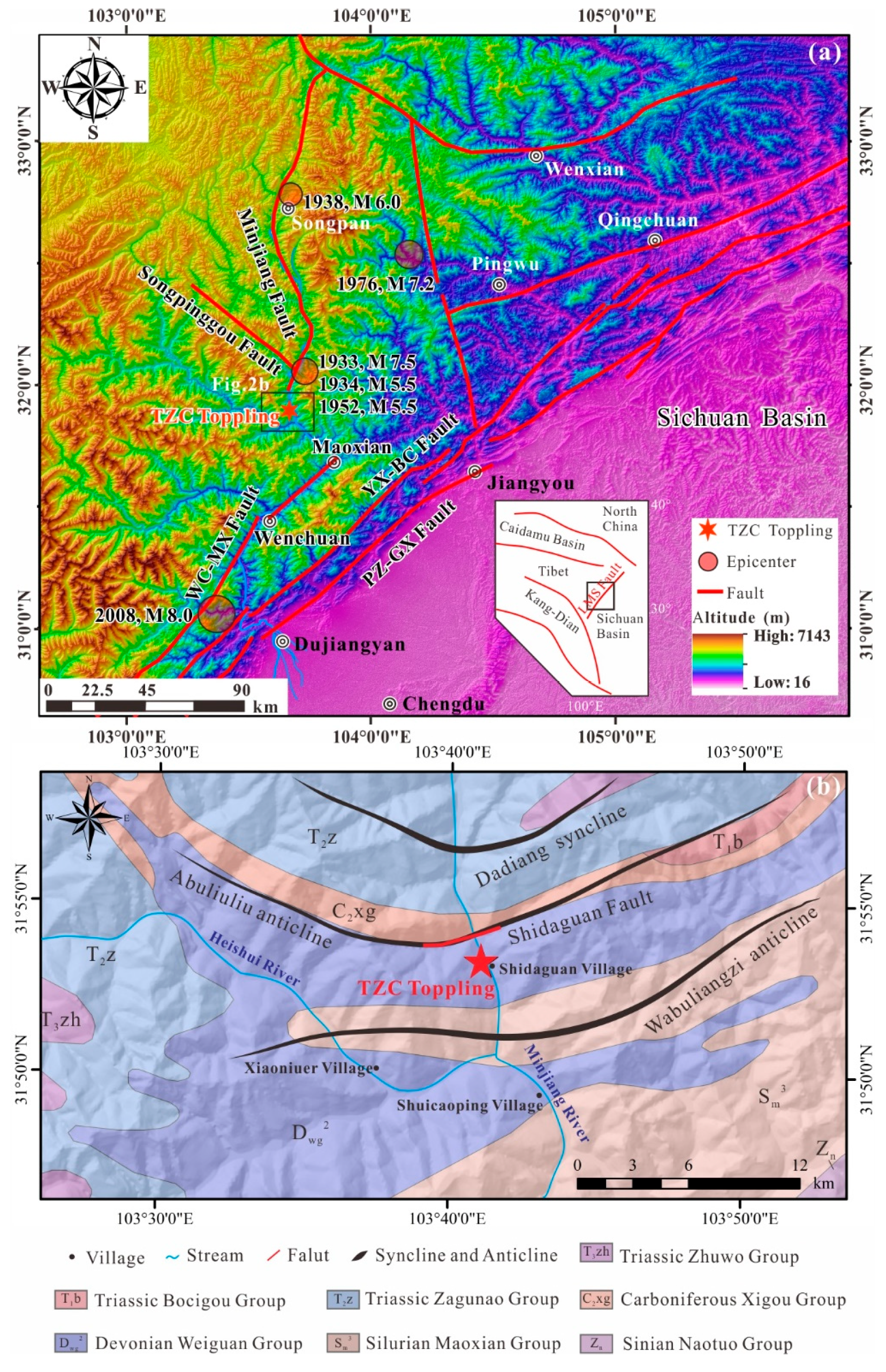
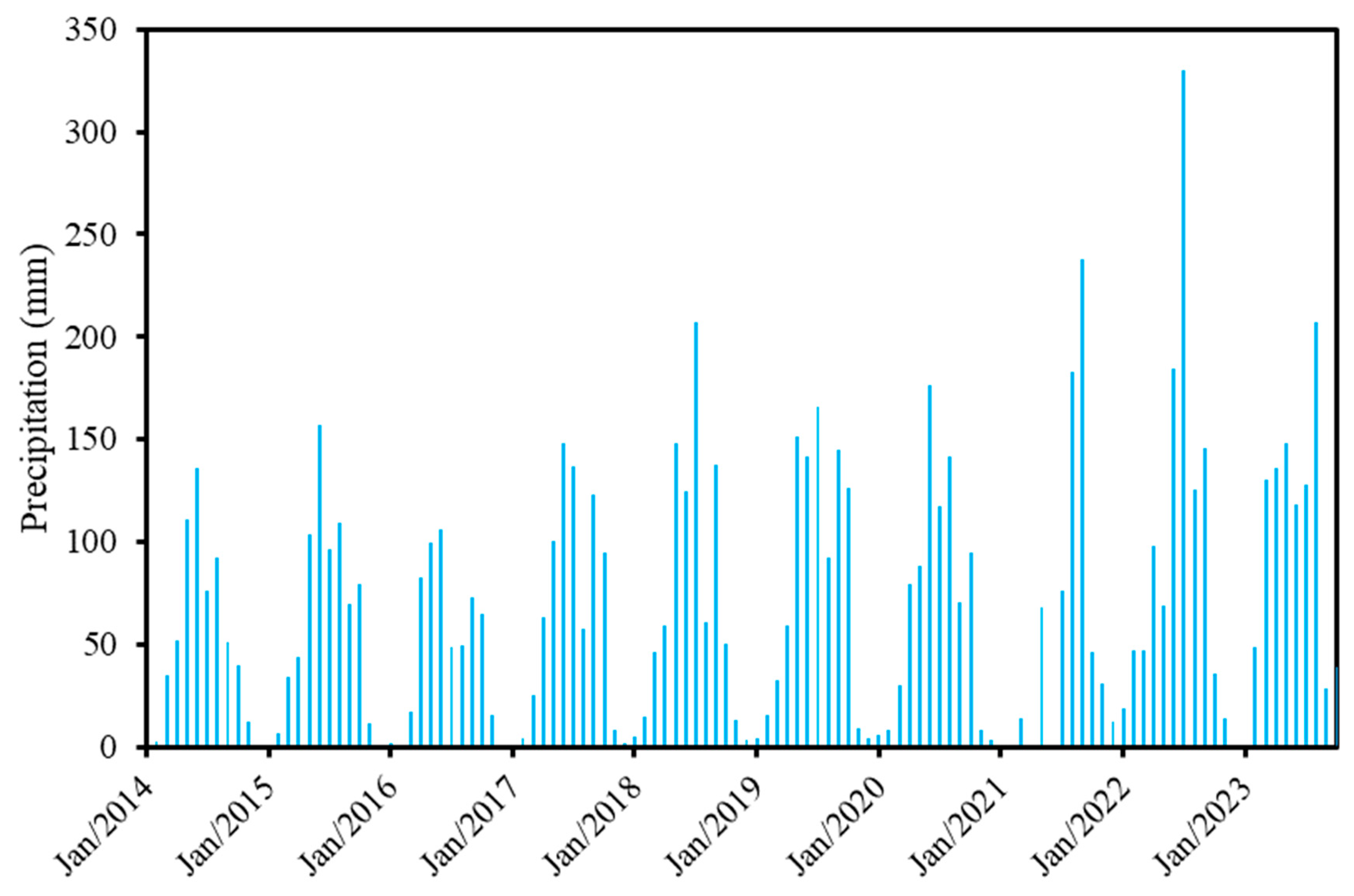
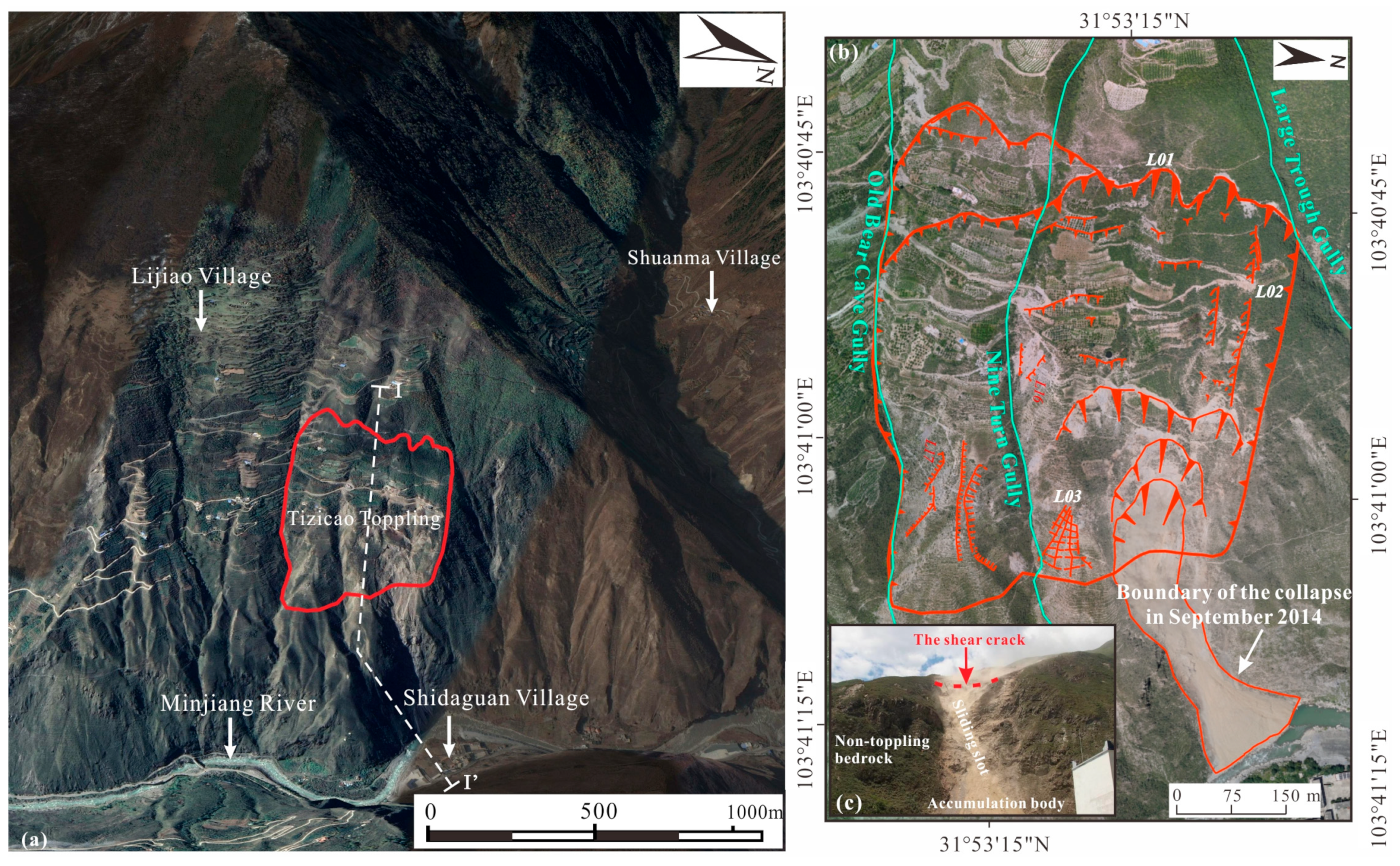



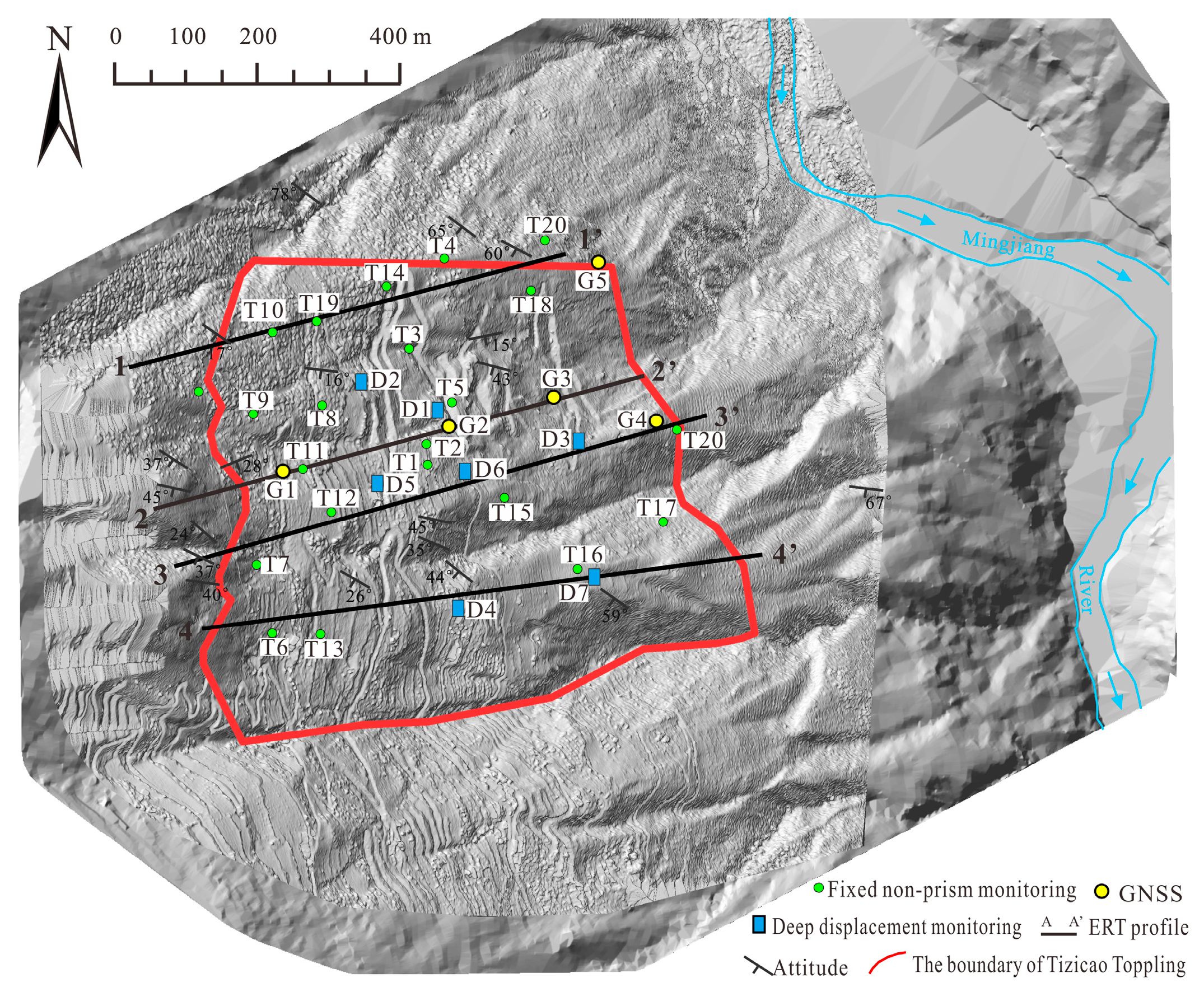
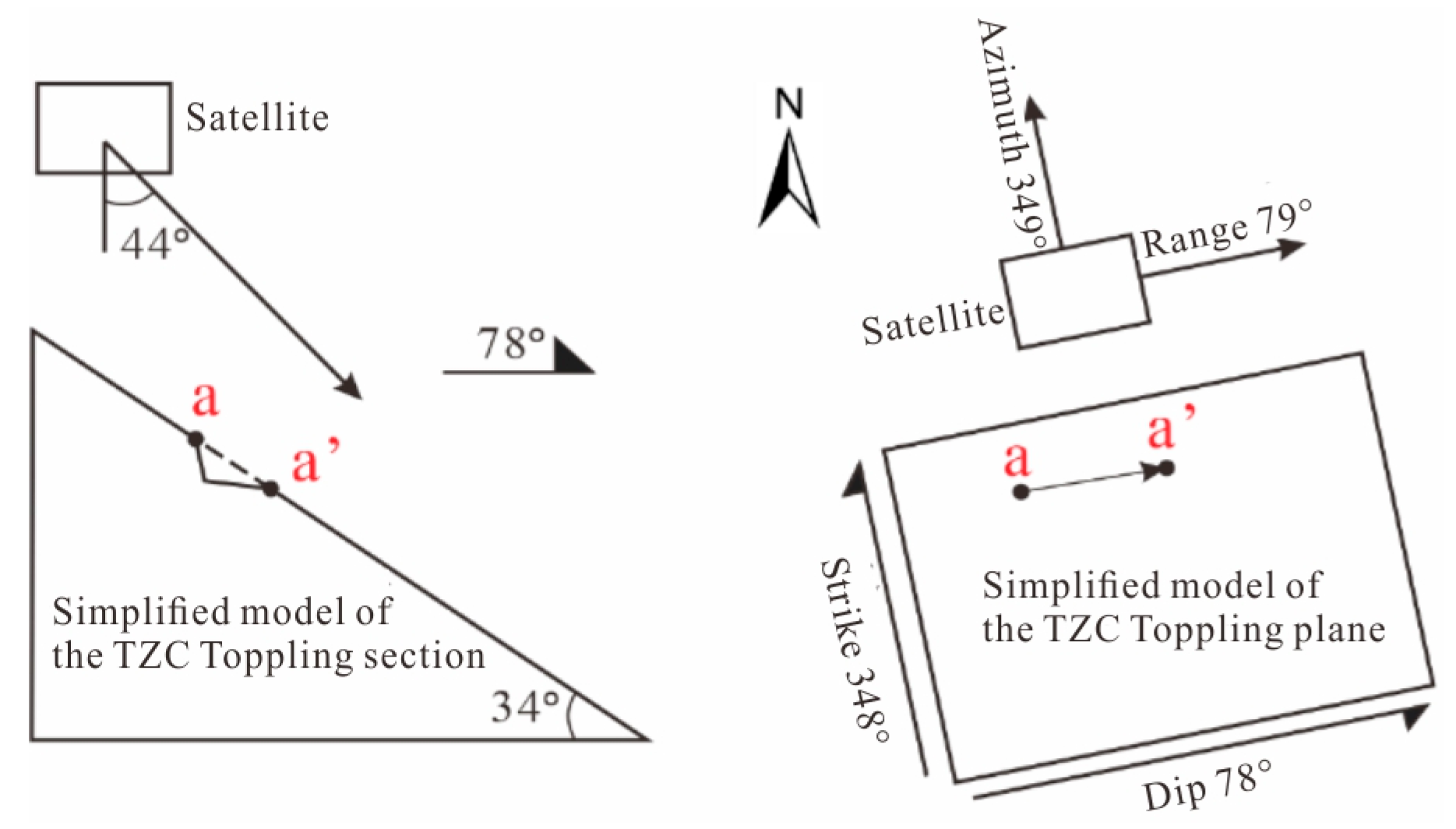

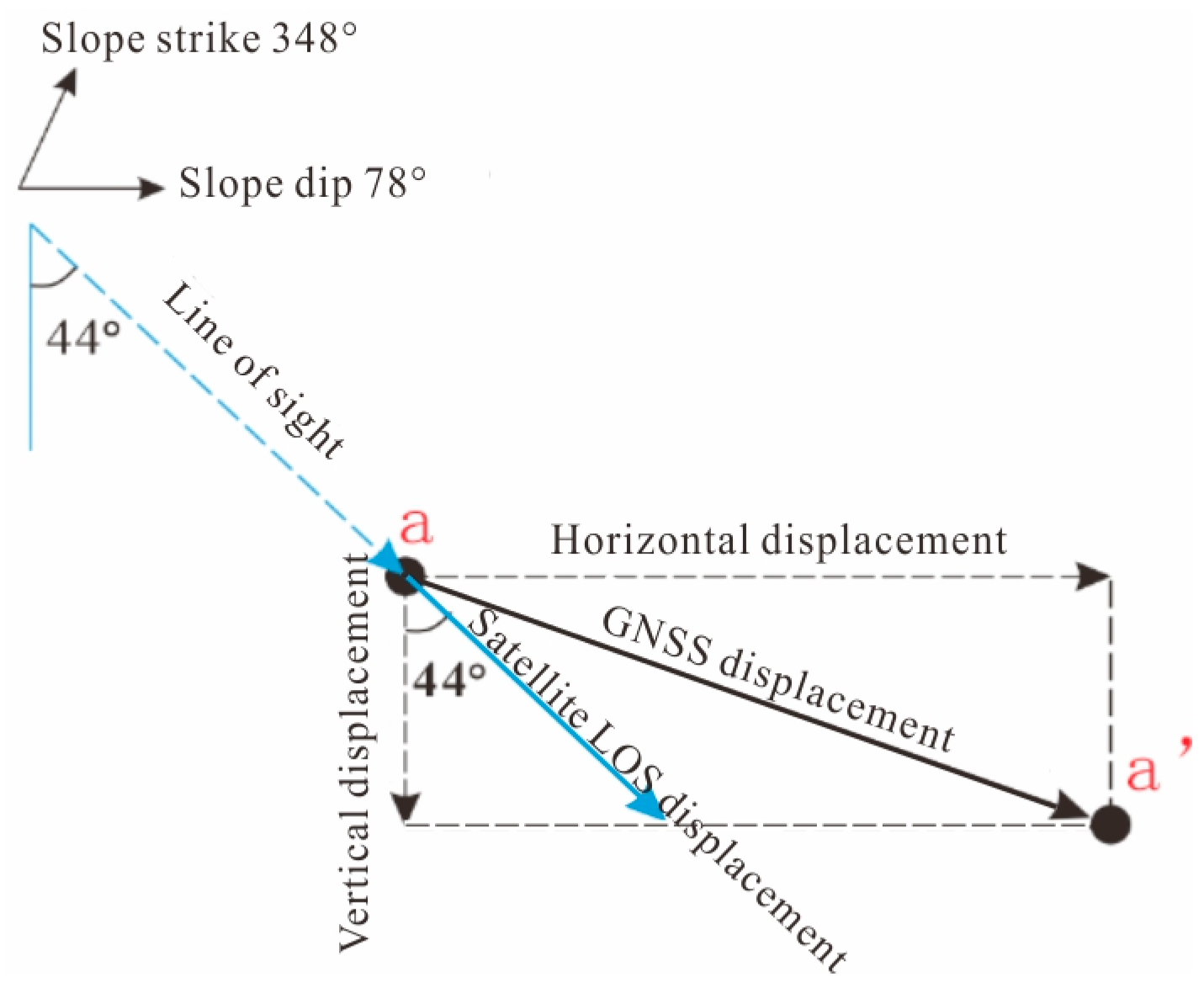

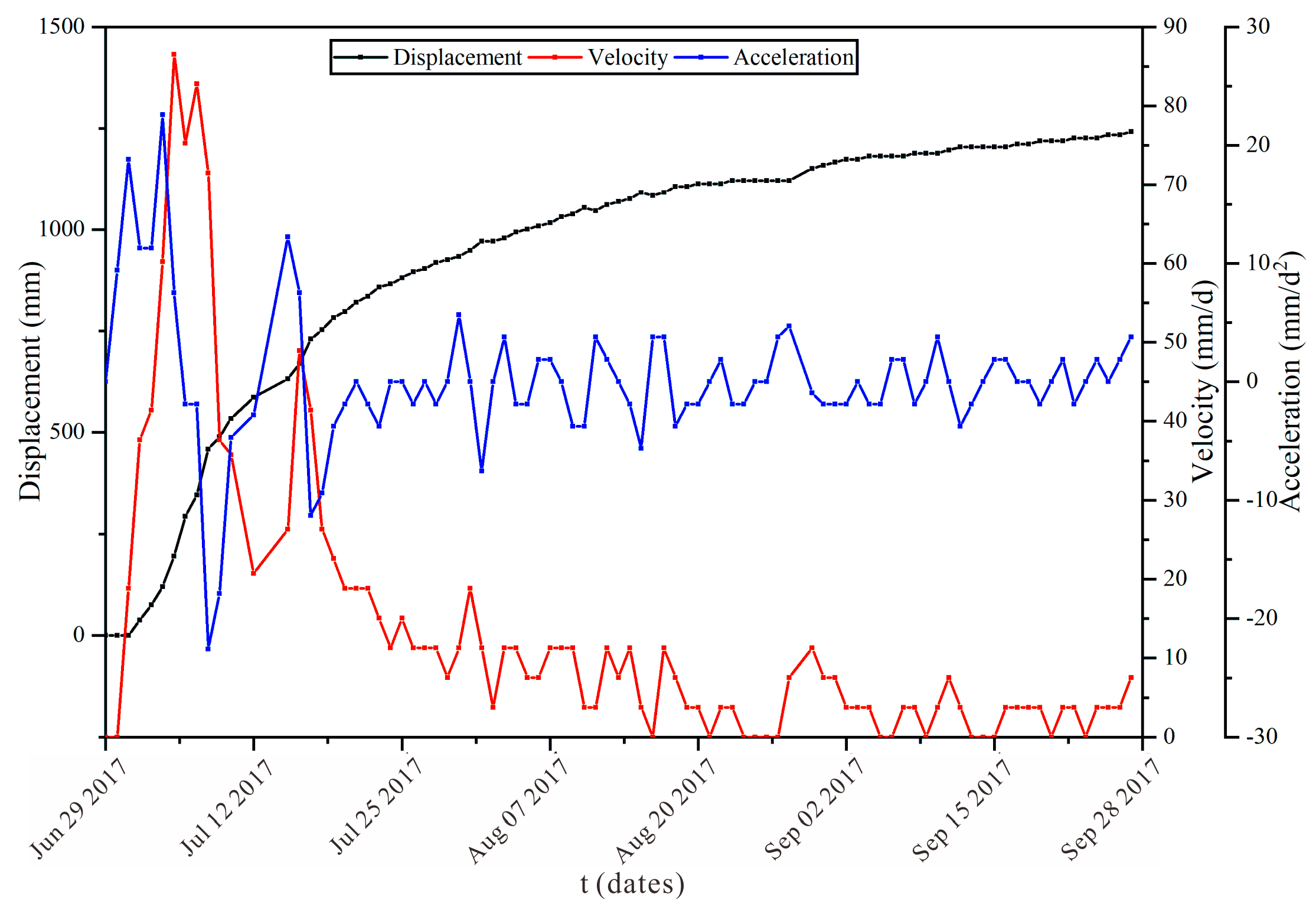
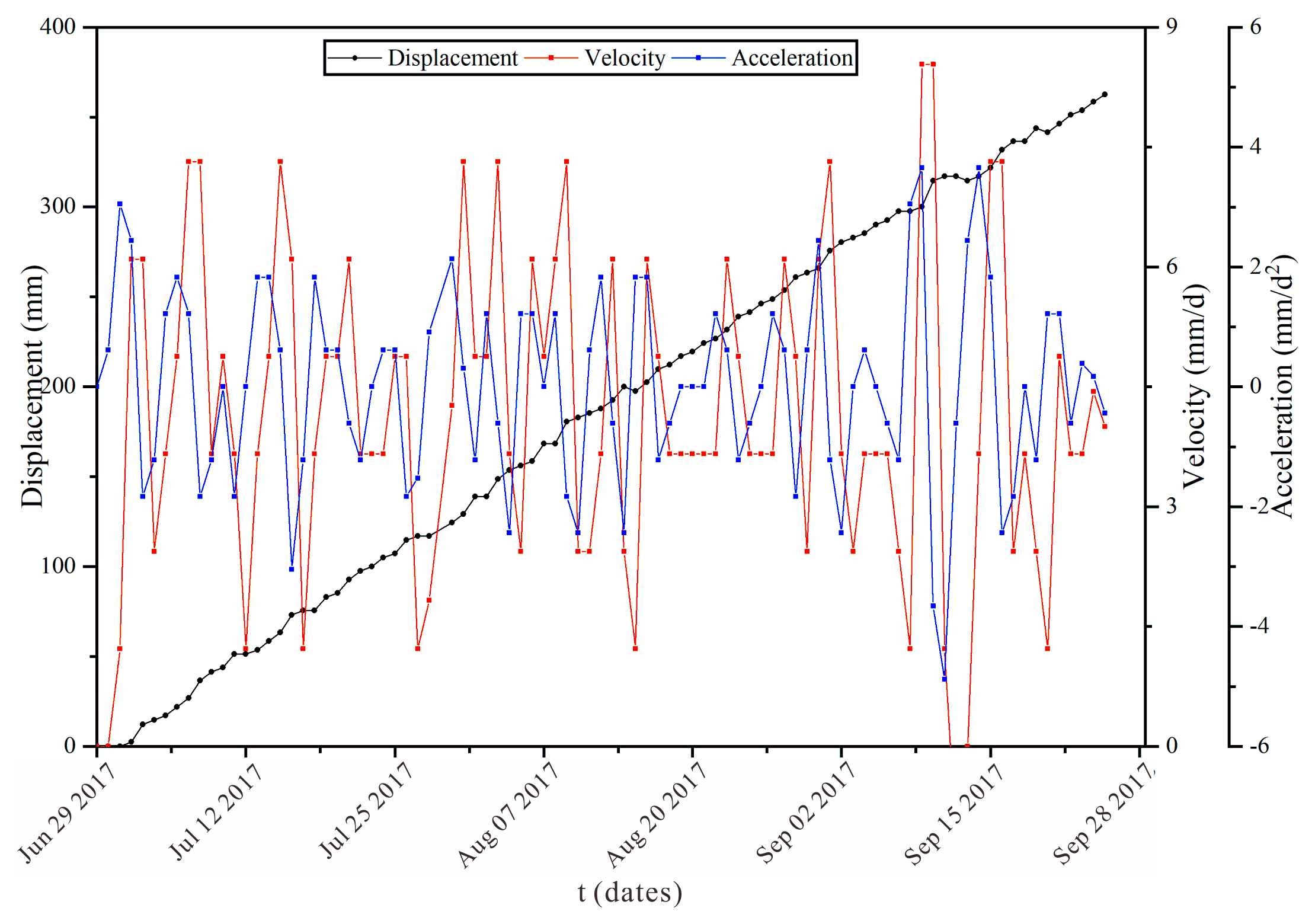

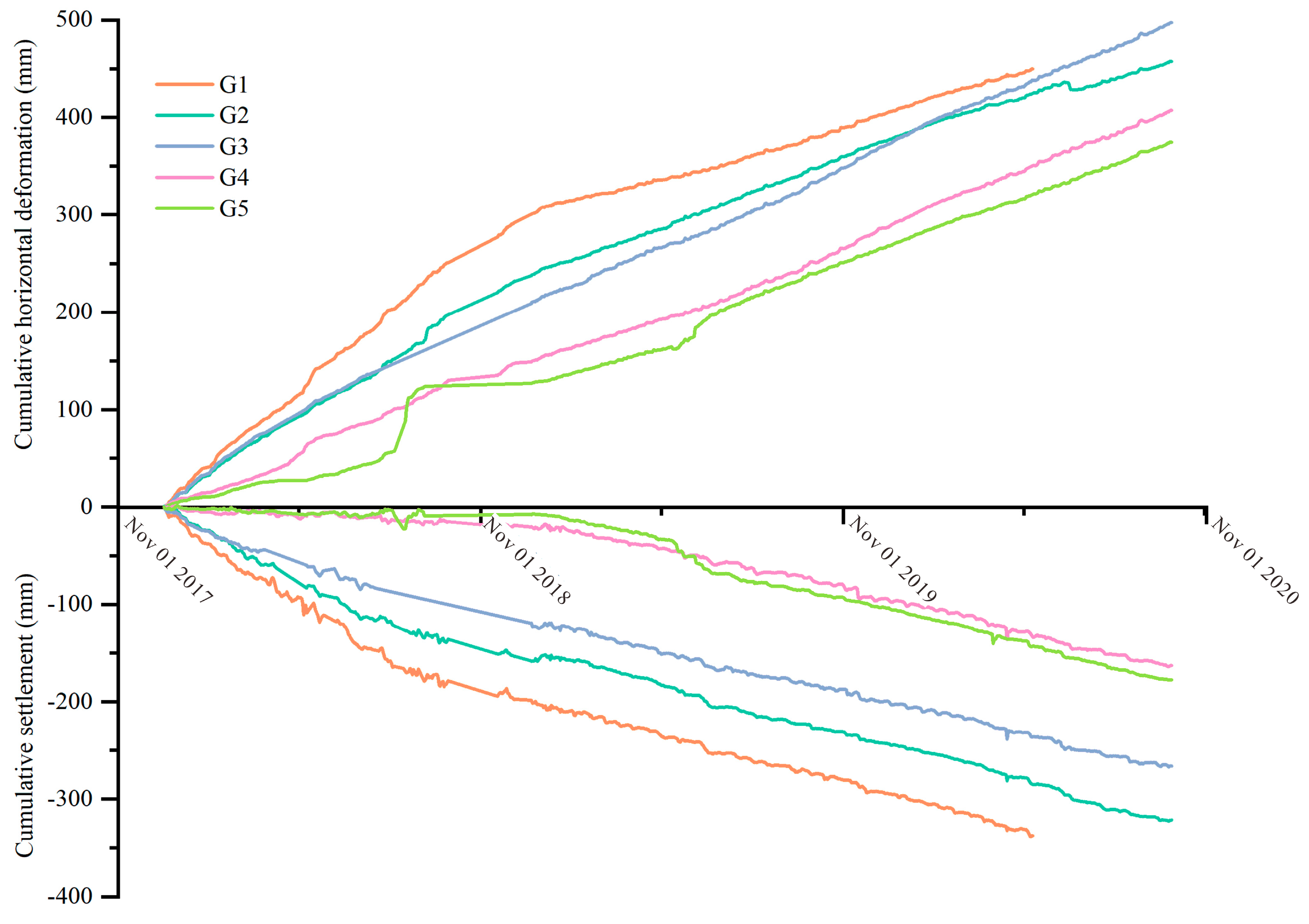
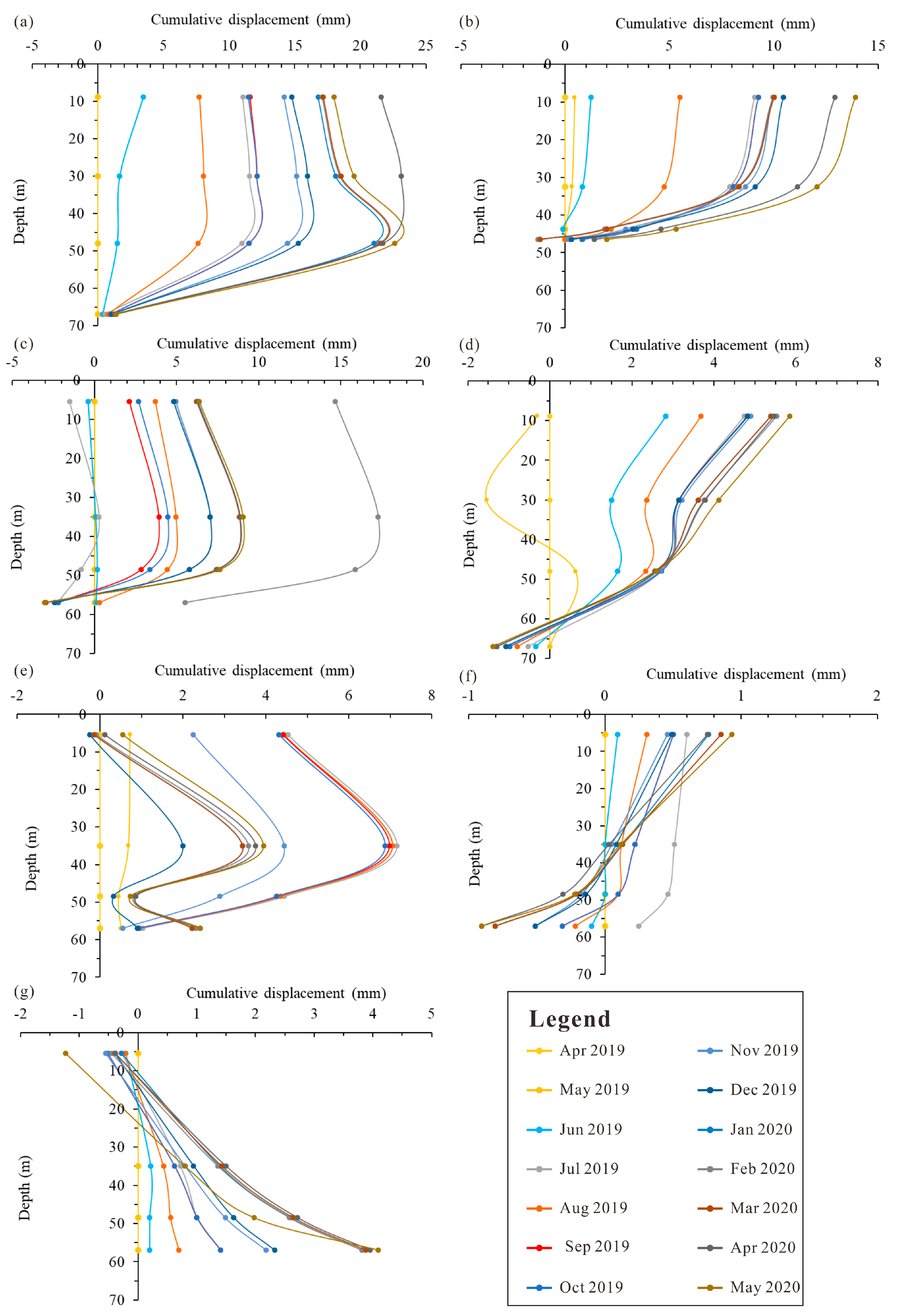
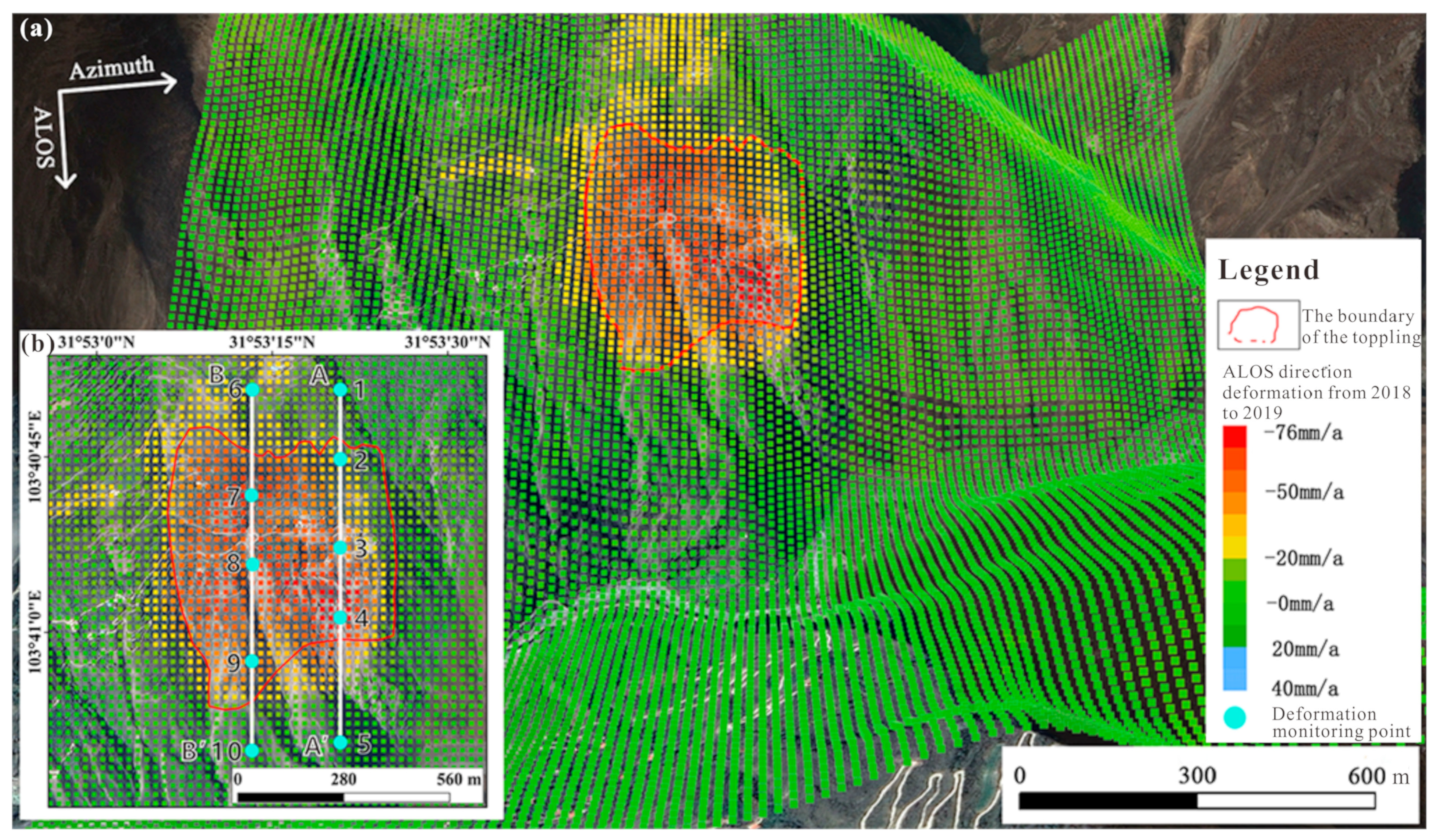

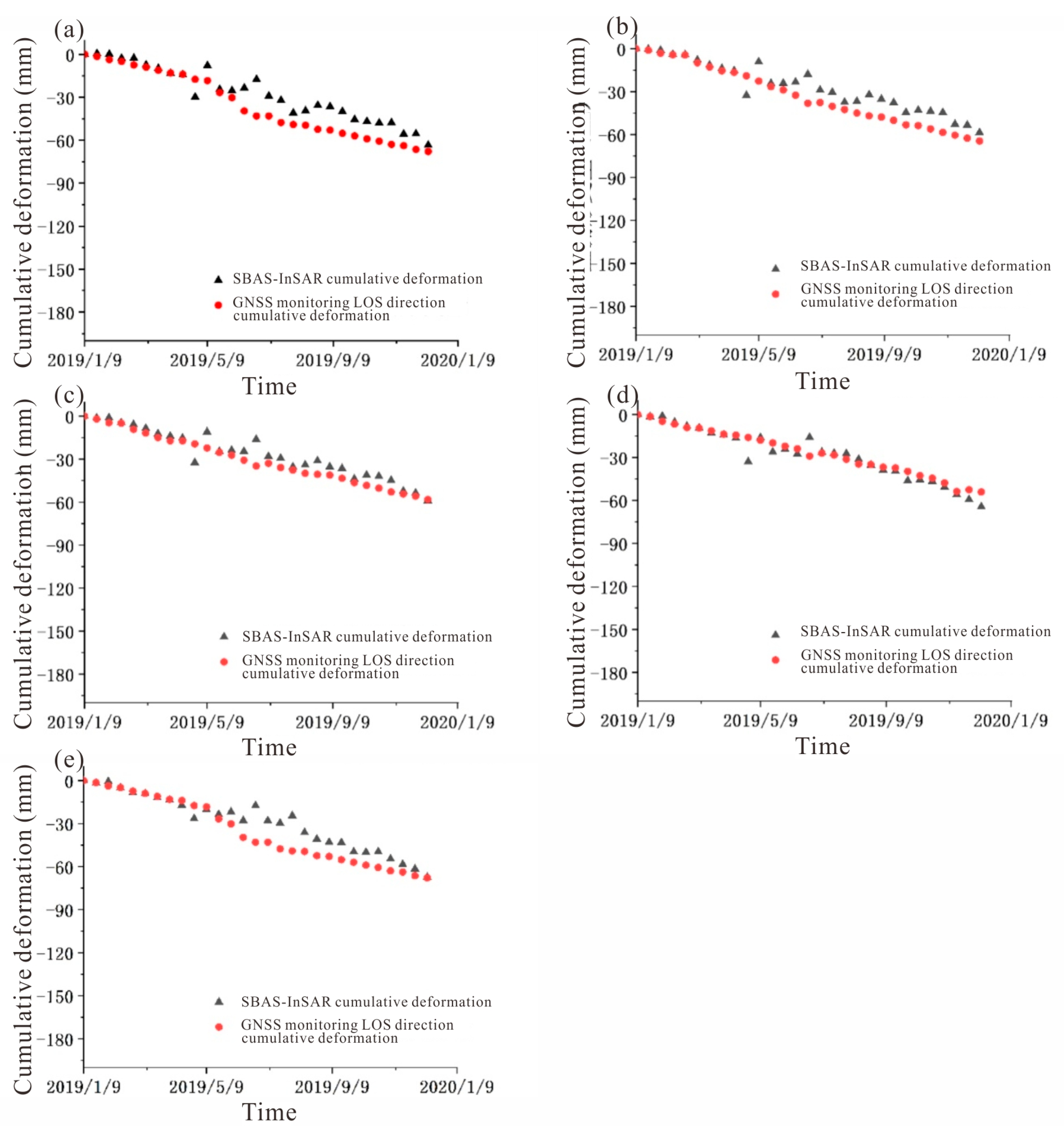


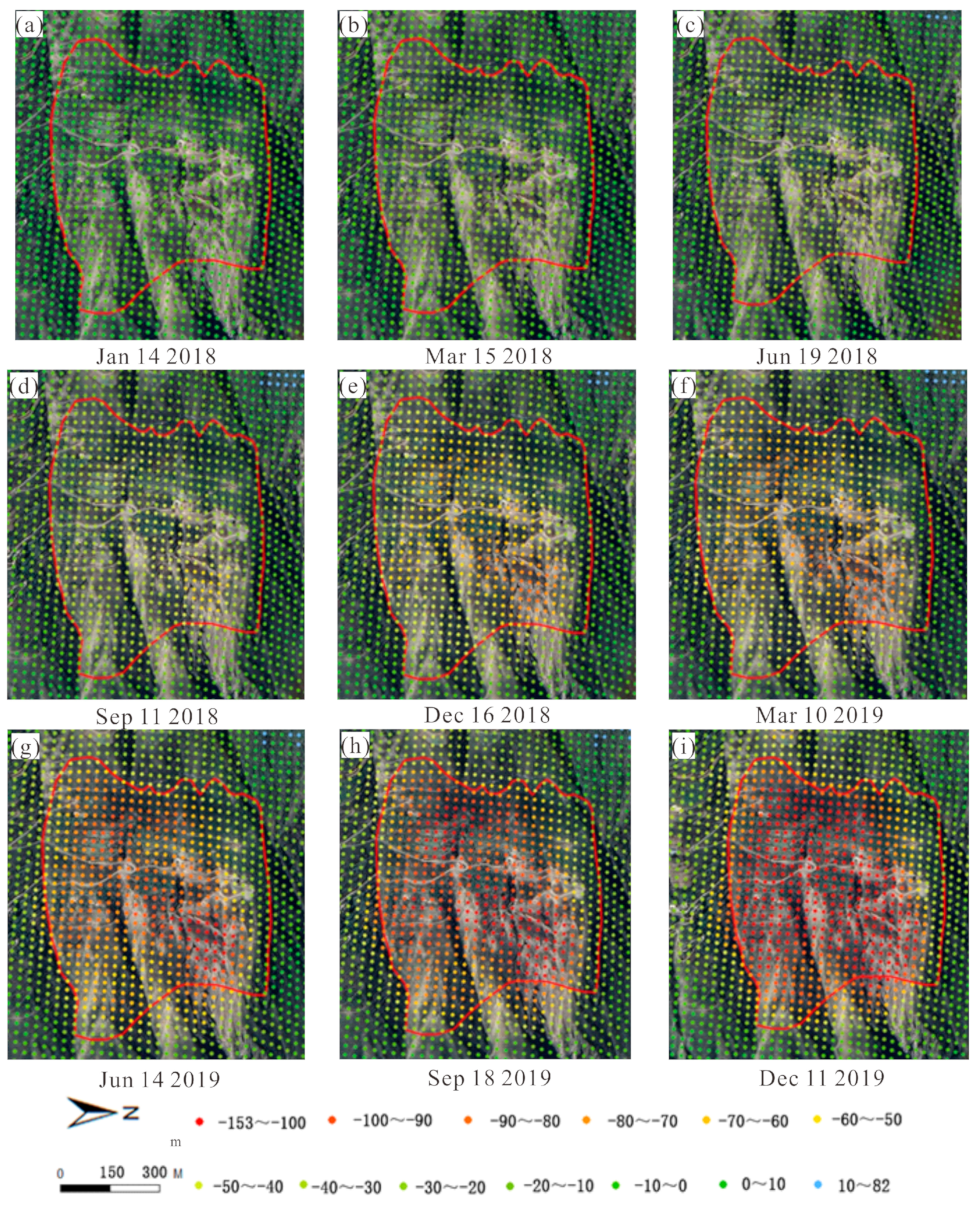
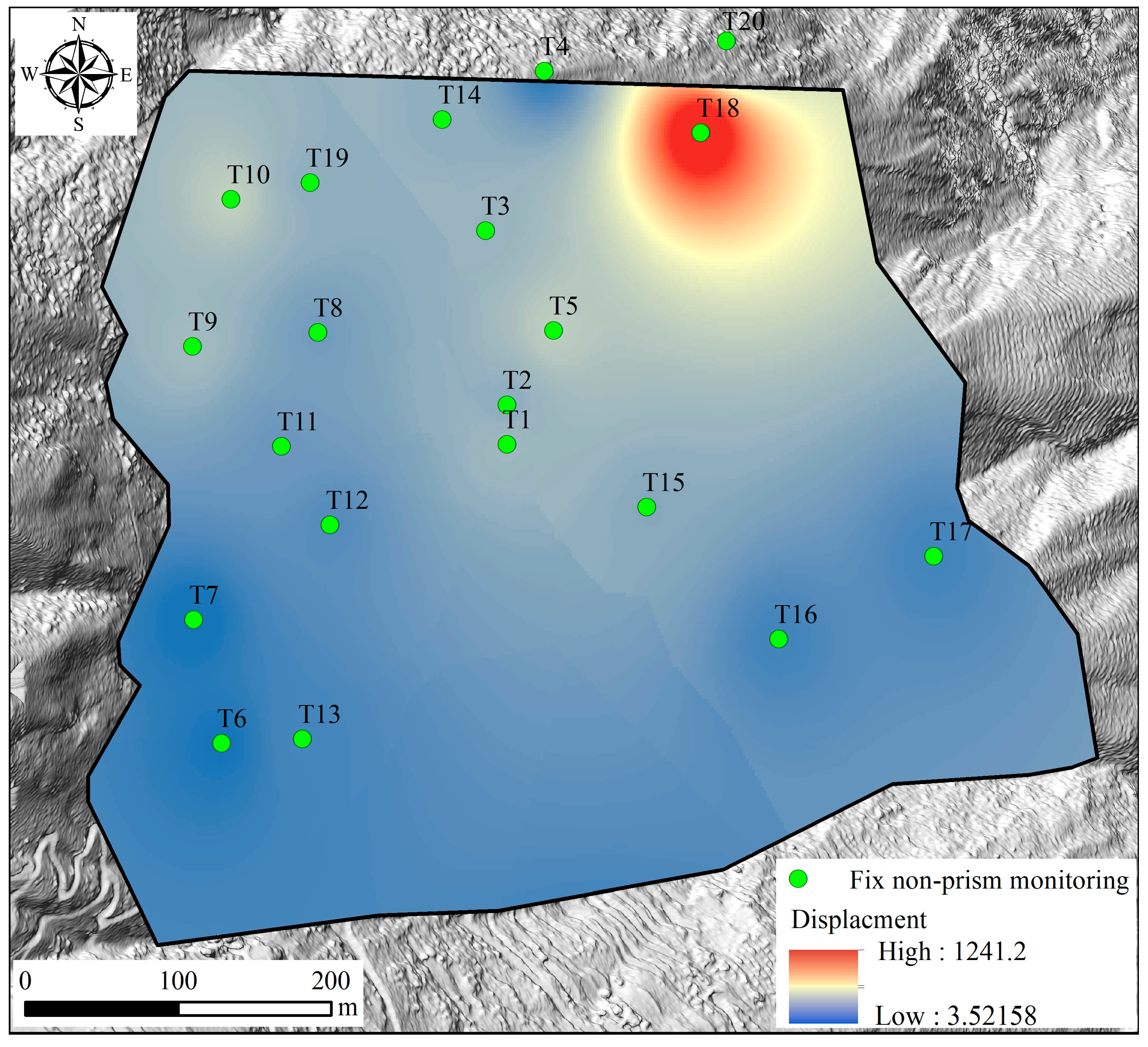
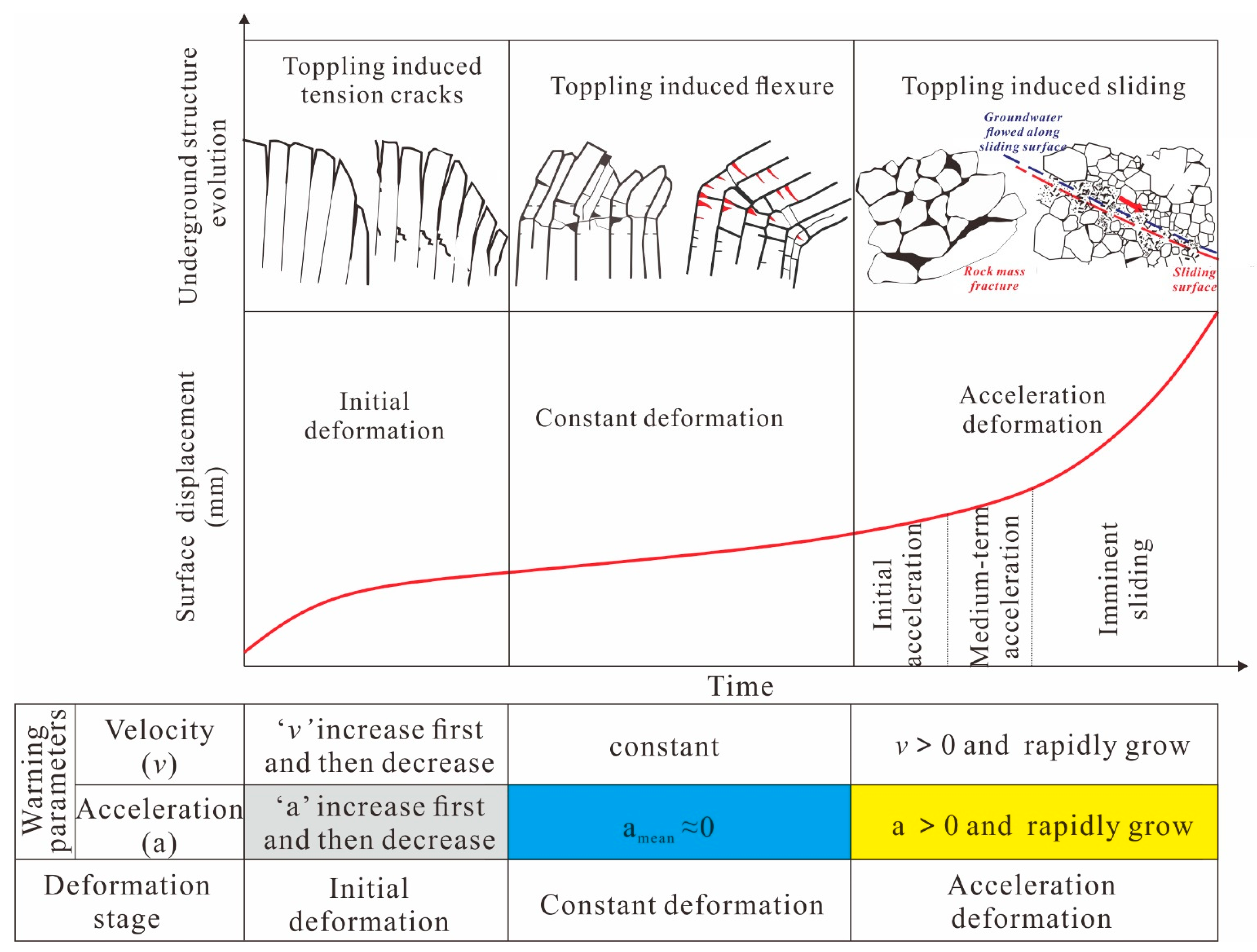
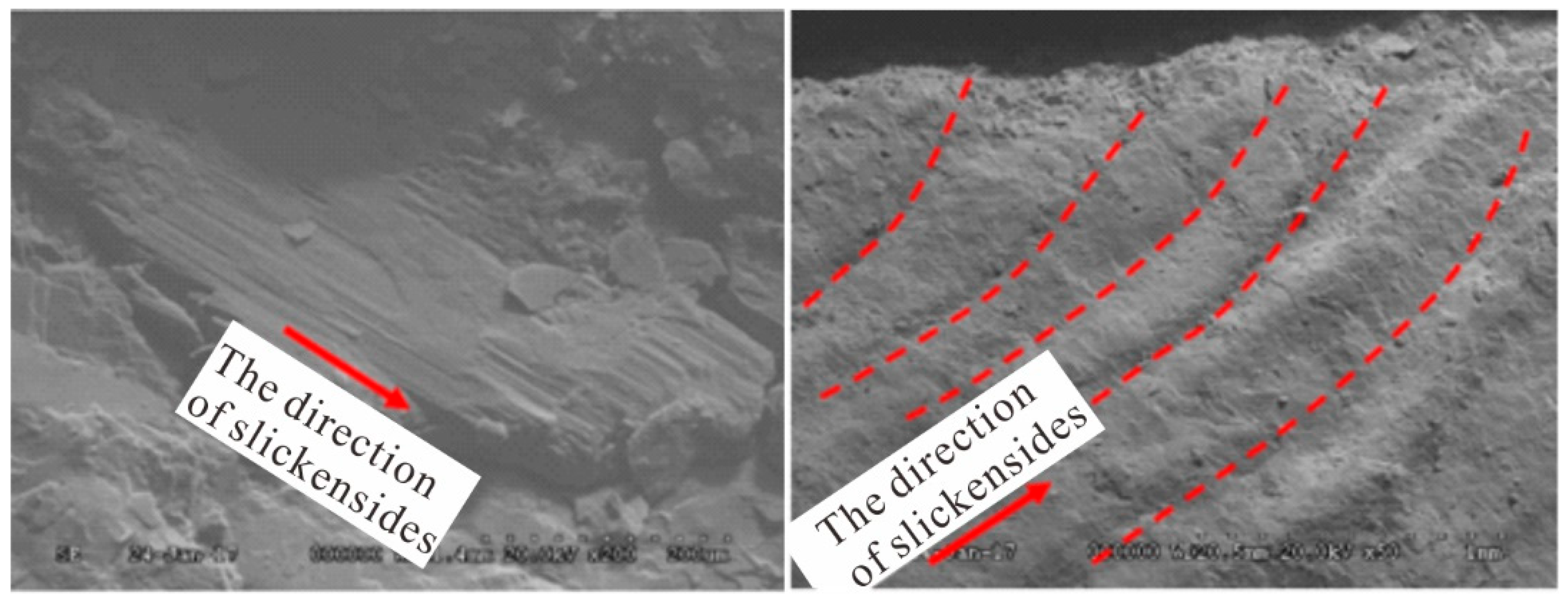
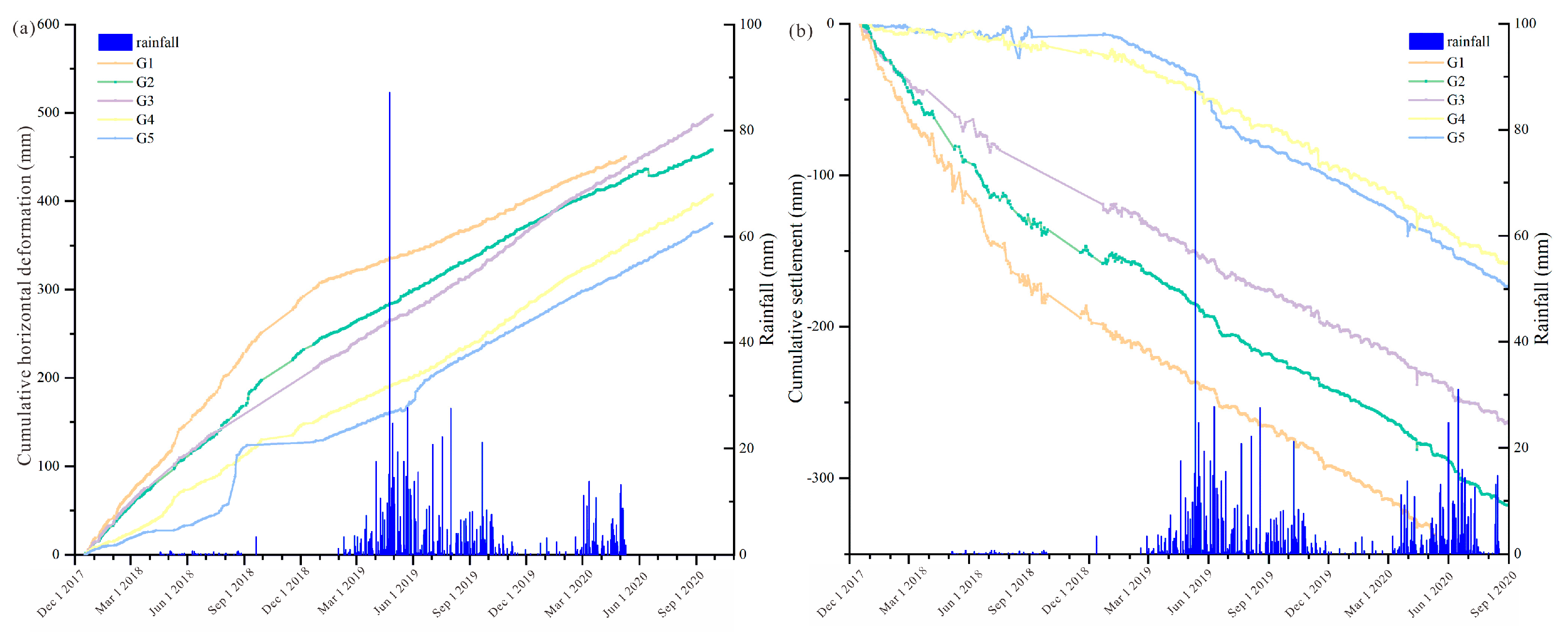

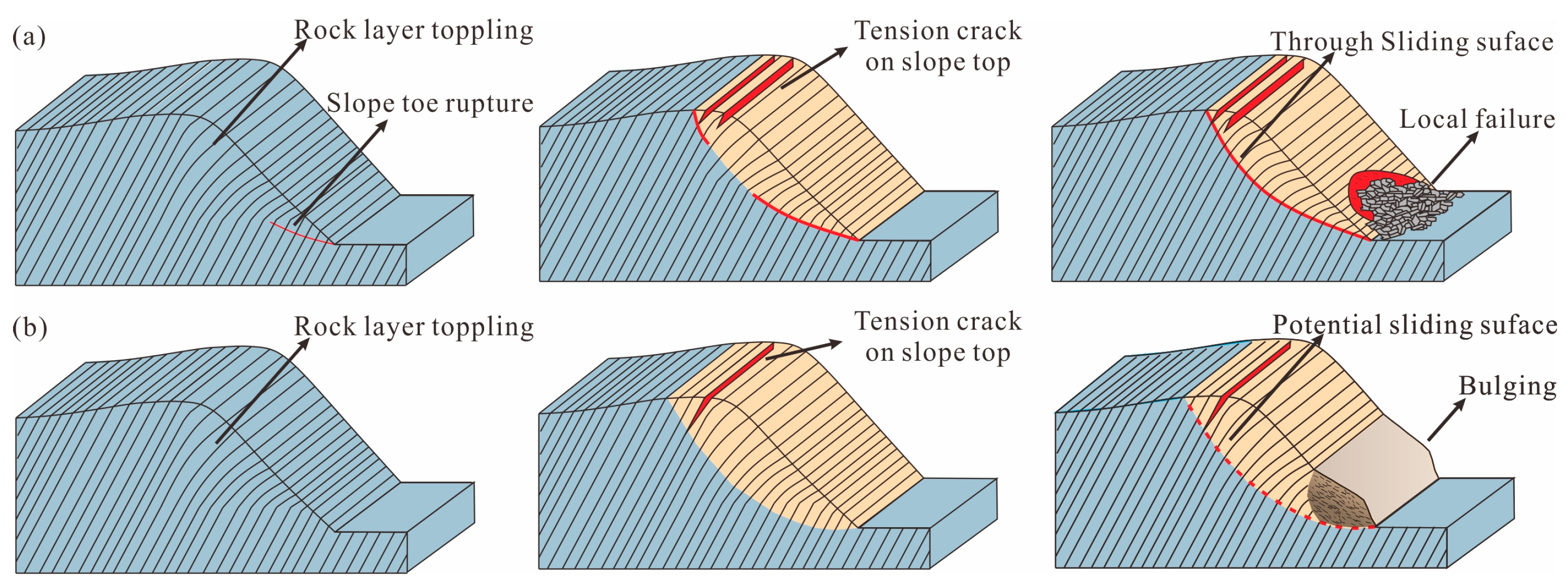
| No. | Image Shooting Time | Satellite Name | Resolution/m |
|---|---|---|---|
| 1 | 9 January 2010 | WorldView-2 | 0.48 |
| 2 | 17 March 2011 | Geoeye-1 | 0.44 |
| 3 | 9 January 2016 | WorldView-2 | 0.48 |
| 4 | 29 July 2017 | / | 0.50 |
| 5 | 23 October 2019 | Pleiades-A | 0.50 |
| 6 | 10 May 2020 | / | 0.50 |
| No. | Point Number | Longitude | Latitude | Annual Average Rate (mm/a) | No. | Point Number | Longitude | Latitude | Annual Average Rate (mm/a) |
|---|---|---|---|---|---|---|---|---|---|
| 1 | 159239 | 103.67737 | 31.889311 | −5.15 | 6 | 159897 | 103.67758 | 31.886811 | −22.00 |
| 2 | 165054 | 103.67924 | 31.889102 | −29.35 | 7 | 167649 | 103.68008 | 31.886811 | −70.17 |
| 3 | 171514 | 103.68133 | 31.889102 | −52.59 | 8 | 172817 | 103.68174 | 31.886811 | −58.68 |
| 4 | 175390 | 103.68299 | 31.889102 | −76.43 | 9 | 179923 | 103.68403 | 31.886811 | −45.94 |
| 5 | 188956 | 103.68695 | 31.889102 | −1.17 | 10 | 187029 | 103.68633 | 31.886811 | −1.53 |
| No. | G1 | G2 | G3 | G4 | G5 | |
|---|---|---|---|---|---|---|
| Indicator | ||||||
| Sig. | 1.3589 × 10−17 | 5.5617 × 10−16 | 7.0319 × 10−16 | 1.0628 × 10−16 | 3.8526 × 10−14 | |
| r | 0.967 | 0.957 | 0.956 | 0.962 | 0.940 | |
| Horizontal Displacement of G1 | Horizontal Displacement of G2 | Horizontal Displacement of G3 | Horizontal Displacement of G4 | Horizontal Displacement of G5 | ||||||
|---|---|---|---|---|---|---|---|---|---|---|
| sig. | sig. | sig. | sig. | sig. | ||||||
| Rainfall | 0.237 ** | 0.000 | 0.275 ** | 0.000 | 0.250 ** | 0.000 | 0.276 ** | 0.000 | 0.288 ** | 0.000 |
| Earthquake | −0.113 | 0.224 | −0.113 | 0.225 | −0.113 | 0.226 | −0.113 | 0.225 | −0.113 | 0.226 |
| Horizontal displacement of G1 | Horizontal displacement of G2 | Horizontal displacement of G3 | Horizontal displacement of G4 | Horizontal displacement of G5 | ||||||
| sig. | sig. | sig. | sig. | |||||||
| Rainfall | 0.236 ** | 0.000 | 0.276 ** | 0.000 | 0.249 ** | 0.000 | 0.273 ** | 0.000 | 0.287 ** | 0.000 |
| Earthquake | −0.109 | 0.240 | −0.113 | 0.225 | −0.096 | 0.305 | −0.082 | 0.379 | −0.138 | 0.137 |
Disclaimer/Publisher’s Note: The statements, opinions and data contained in all publications are solely those of the individual author(s) and contributor(s) and not of MDPI and/or the editor(s). MDPI and/or the editor(s) disclaim responsibility for any injury to people or property resulting from any ideas, methods, instructions or products referred to in the content. |
© 2023 by the authors. Licensee MDPI, Basel, Switzerland. This article is an open access article distributed under the terms and conditions of the Creative Commons Attribution (CC BY) license (https://creativecommons.org/licenses/by/4.0/).
Share and Cite
Cui, S.; Wang, H.; Pei, X.; Luo, L.; Zeng, B.; Jiang, T. Research on Deformation Evolution of a Large Toppling Based on Comprehensive Remote Sensing Interpretation and Real-Time Monitoring. Remote Sens. 2023, 15, 5596. https://doi.org/10.3390/rs15235596
Cui S, Wang H, Pei X, Luo L, Zeng B, Jiang T. Research on Deformation Evolution of a Large Toppling Based on Comprehensive Remote Sensing Interpretation and Real-Time Monitoring. Remote Sensing. 2023; 15(23):5596. https://doi.org/10.3390/rs15235596
Chicago/Turabian StyleCui, Shenghua, Hui Wang, Xiangjun Pei, Luguang Luo, Bin Zeng, and Tao Jiang. 2023. "Research on Deformation Evolution of a Large Toppling Based on Comprehensive Remote Sensing Interpretation and Real-Time Monitoring" Remote Sensing 15, no. 23: 5596. https://doi.org/10.3390/rs15235596
APA StyleCui, S., Wang, H., Pei, X., Luo, L., Zeng, B., & Jiang, T. (2023). Research on Deformation Evolution of a Large Toppling Based on Comprehensive Remote Sensing Interpretation and Real-Time Monitoring. Remote Sensing, 15(23), 5596. https://doi.org/10.3390/rs15235596







